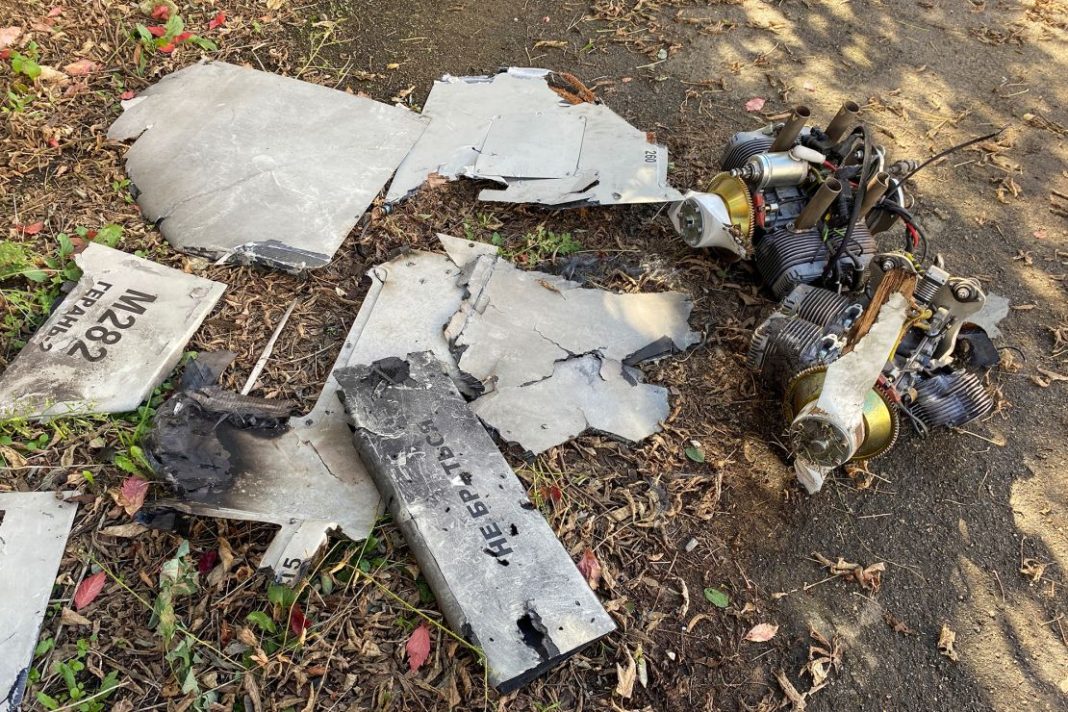The Pakistan army successfully intercepted and destroyed 30 Israeli-made Heron drones that were sent by India to target both civilian and military sites on Thursday. This operation resulted in significant losses for the enemy at various locations along the Line of Control (LoC) in Kashmir.
According to the Inter-Services Public Relations (ISPR), the downed drones were spotted over several cities, including Rawalpindi, Gujrat, Attock, Gujranwala, Lahore, Sheikhupura, Nankana, Ghotki, and Karachi’s Malir district.
On the LoC, security sources reported that Pakistani troops effectively countered the Indian army’s unprovoked firing in the Pando sector, destroying their battalion headquarters in Nanga Tak and inflicting heavy losses elsewhere.
Loud explosions echoed across multiple areas as Pakistan’s air defense systems engaged the intruding drones. An ISPR official noted that this was the first time an Israeli unmanned aerial vehicle (UAV) – the Heron MK 2, capable of flying at altitudes up to 35,000 feet – was neutralized in combat.
The military confirmed that the drones were indeed of Israeli origin, with engines produced by Britain’s UAV Engines Ltd. The ISPR attributed India’s drone aggression to a sense of “desperation” following Pakistan’s strong response to its strikes on Wednesday, which resulted in the loss of aircraft, drones, and border posts.
“These cowardly attacks reflect New Delhi’s panic and strategic disarray,” the military stated, adding that Indian forces also suffered considerable damage along the Line of Control (LoC). Recovery efforts for the wreckage of the drones are currently underway in the affected regions.
The Pakistan Army is responding decisively and strategically, effectively countering all enemy plans, according to the ISPR. They reported that all intruding drones have been neutralized through a mix of soft-kill and hard-kill measures.
In Lahore, though, four soldiers were injured, and there was some minor damage to military assets as drones tried to breach security near Walton Old Airport and Burki. Local residents rushed into the streets due to the attempted strikes in these sensitive areas.
Debris was found near Jallo Park, which has now been sealed off, with police and elite forces securing the site. Authorities reassured the public that the explosions heard in Walton and surrounding areas were part of mock exercises, urging residents to stay indoors for safety.
In other locations like Walton and Sheikhupura, drones fell into agricultural fields, reportedly injuring several civilians. On Thursday morning in Gujranwala, two explosions were heard, prompting air defense systems to activate in the Cantt area, where one drone was successfully taken down.
Tragically, two civilians lost their lives and one was injured in Rawalpindi and Attock, where drones crashed in both urban and semi-rural settings. In Rawalpindi, debris landed on a shop near Stadium Road’s food street, breaking windows and injuring Tauqir Shah and Haider Ali.
Haider, a contractor working for the stadium authorities, unfortunately succumbed to his injuries at Benazir Bhutto Hospital. Witnesses reported that all gates of the Rawalpindi Cricket Stadium were closed, and security personnel cordoned off the area. Another drone crashed near the Race Course Ground, causing damage to a residential building.
In Gujrat, drone wreckage was discovered in Pir Jhand village. Additional drones were downed in Nankana and Sheikhupura, with debris landing in open fields. In the Jabi Khasran area of Attock, 65-year-old Mahboob Elahi was killed after being injured by a falling drone in his fields.
In Sindh, Mukhtiar Ahmed lost his life, and another villager was hurt in a drone strike that hit Sarfaraz Laghari village in the Ghotki district. Meanwhile, in Sharafi Goth, located in the Malir district of Karachi, a drone was brought down, prompting police to seal off the area.
A false alarm about a drone strike near Faisal Mosque was quickly dismissed by Islamabad’s deputy commissioner, Irfan Nawaz Memon, who cautioned against the spread of fake sirens and misinformation that could lead to unnecessary panic.
Authorities in Islamabad, Lahore, and Karachi are urging residents to avoid sharing or believing unverified news. “Stick to official statements from credible government sources,” officials advised.
The ISPR reported that Indian drones were also neutralized in areas like Chakwal, Bahawalpur, Miano, Chhor, and others. These drone strikes occurred on the second day of significant clashes between the two nuclear-armed neighbors. Defence Minister Khawaja Asif indicated that Pakistan’s response is “increasingly certain.”
“The escalation follows India’s cowardly attack on May 6/7, which led to the destruction of five advanced aircraft, drones, several military posts, and casualties among Indian troops,” the ISPR news release stated.
“In a state of panic and confusion, India has turned to using Israeli-made Harop drones to strike Pakistani territory. These unprovoked attacks clearly show India’s desperation and frustration as it continues to face heavy losses along the Line of Control.”
Pakistan’s retaliation “is becoming increasingly certain now,” the defence minister told Reuters. “I won’t say it’s 100% guaranteed, but the situation has become very challenging. We have to respond,” he added.
What is Harop?
According to a report from the Times of Israel, the Harop, created by Israel Aerospace Industries, is a type of loitering munition. It can fly to its targets and then strike by crashing into them, all under the operator’s command, which means it self-destructs in the process.
The Harop is packed with advanced technology, including electro-optical (EO), infrared (IR), and forward-looking infrared (FLIR) sensors, along with a color CCD camera and anti-radar homing features. This setup allows it to detect and identify targets, as noted in a report by the Eurasian Times.
Additionally, the Harop can search for targets in a specified area for up to nine hours. It can locate and identify them, plan an attack route, and then execute the strike from various angles, whether shallow or steep. Thanks to its resistance to GNSS jamming, the Harop effectively navigates communication hurdles.
Launched from canisters on trucks or naval vessels, the Harop can be deployed in a variety of terrains and environments with ease. If it doesn’t engage a target, the drone will return to base. It’s designed to minimize its radar signature, ensuring stealth and low observability.
Why India used Harop?
According to sources within Pakistan’s security forces, the Indian Air Force (IAF) may be feeling a bit cautious about launching more manned air missions after losing five of its warplanes during a clash with the Pakistan Air Force (PAF) on the night of May 6-7.
They also mentioned that India seems to be trying to shift focus away from its military losses with provocative actions aimed at satisfying its domestic audience. The military stated that it remains on high alert, responding to each act of aggression with a “firm and proportionate” strategy.
It was quite an embarrassment for India when it attempted a missile strike on Pakistan but ended up losing five jets, including three of its modern Rafale aircraft, during the PAF’s counterattack. New Delhi has yet to officially acknowledge the downing of the Rafale jets.
However, a senior French intelligence official confirmed to CNN that one Rafale jet was indeed shot down by Pakistan, marking the first time one of these advanced French aircraft has been lost in combat.
An American commentator on CNN pointed out that the potential loss of Rafale jets would significantly undermine India’s claims of air superiority, which have largely been built around the introduction of these French-made warplanes.
Some experts have suggested that the confrontation between the two nations serves as a test of both Chinese and Western military technologies, especially following Pakistan’s acquisition of J-10C jets from China in response to India’s Rafale fleet. Analysts have observed that China’s J-10C jets are proving to be quite effective, potentially altering the regional balance of power.
For the latest updates and insights on new developments, visit the NEWSON



